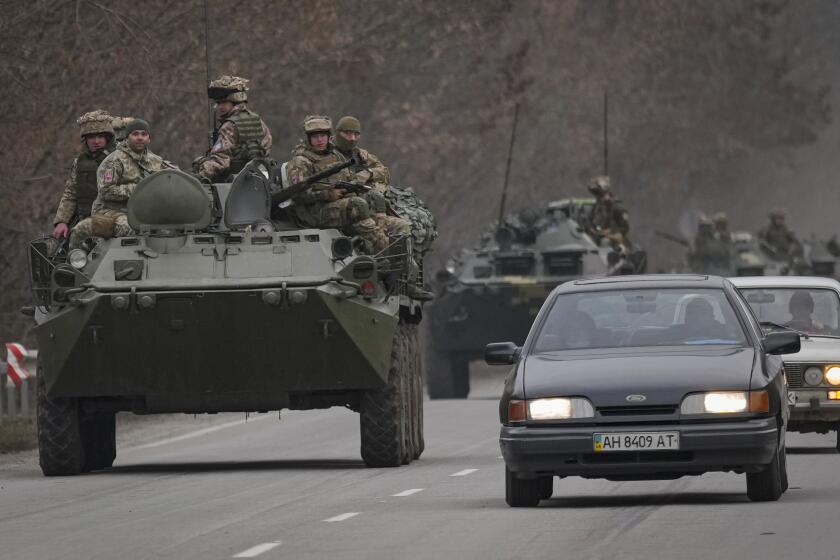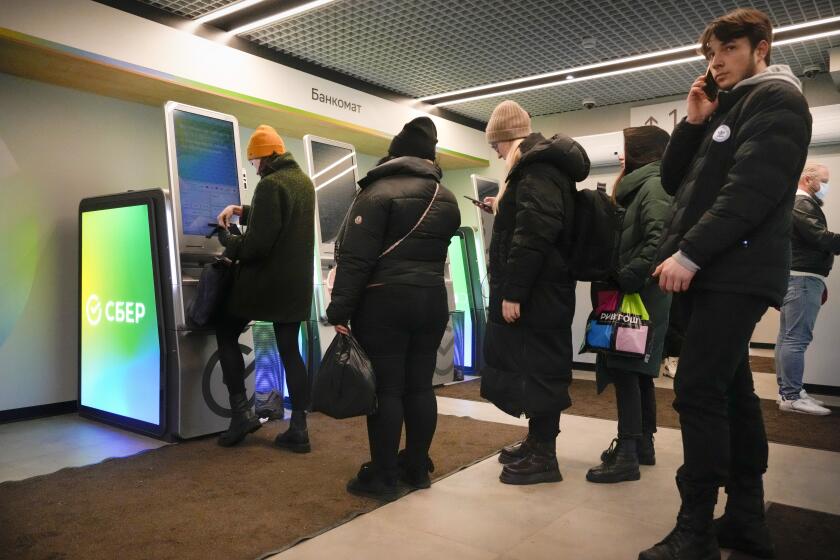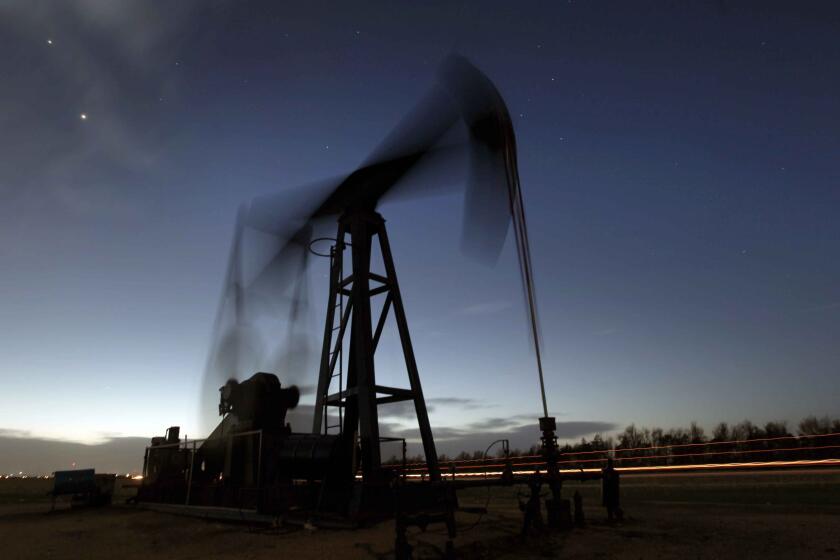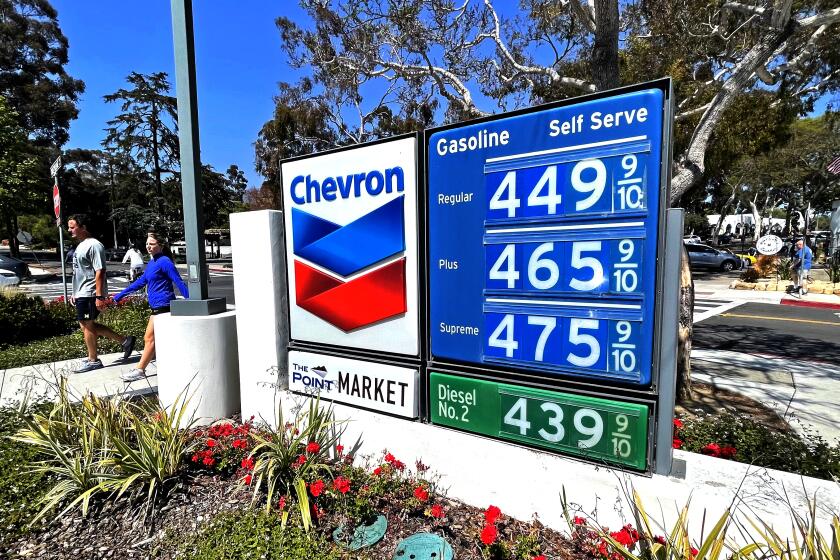Rising gas prices from Russia-Ukraine conflict will hit Angelenos who can least afford it
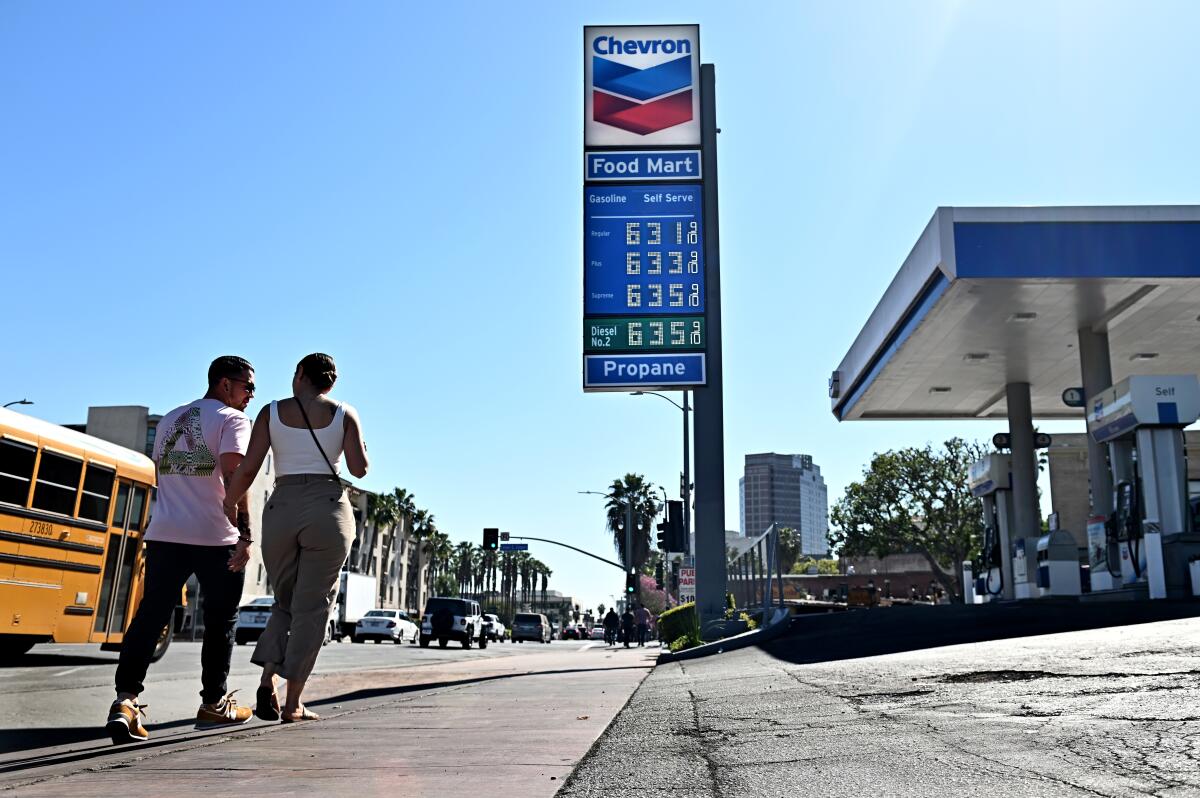
- Share via
Jose Mendoza’s semitruck rumbled into a gas station as he prepared for a once-a-week routine that has grown excruciating in recent months: watching the digital numbers on the diesel pump ratchet up until his 100-gallon tank is full.
The price tag on Monday? $550.
Mendoza — who lives in Moreno Valley and often hauls clothes, makeup and, these days, personal protective equipment — works as an independent contractor. But he is locked into specific shipments, so he can’t switch up his route in an effort to save gas. And the fuel surcharge the government pays his company to help offset prices almost never makes it down to him, Mendoza said, so more expensive gas translates to a pay cut.
“It makes it harder to pay my bills,” he said.
Even before last week, when Russia, one of the world’s top producers of petroleum and other crude oil, invaded neighboring Ukraine and set off Europe’s largest ground war in 75 years, gas prices had ballooned in reaction to pandemic supply-chain issues and inflation.
In L.A. County, the average cost of a gallon of regular-grade fuel is $4.90 — up from $4.67 a month ago and $3.75 a year ago, according to the American Automobile Assn. In Orange County, the average is up to $4.87 from $4.65 a month ago and $3.73 a year ago.
The escalating Ukraine conflict is among a trifecta of factors that will disproportionately affect low-income earners — especially those who, like Mendoza, rely on their vehicles to make a living.
“If you’re a lower-income person commuting from Riverside into Irvine, it’s going to hit you really hard,” said Eric Swanson, a professor of economics at UC Irvine.
Russian tanks and troops crossed into Ukraine on Thursday after a night of shelling. But why is Russia attacking Ukraine? What is Putin’s goal?
While gasoline isn’t a big part of the average American’s budget — about 3%, Swanson said, compared with about 40% for housing costs, which also are rising — hikes in gas prices are regressive, meaning they hit lower-income people relatively harder than higher earners. And increased gas prices create a ripple effect, Swanson said, eventually leading to higher prices for almost all transported goods.
“Even before Ukraine, we were having the worst inflation since 1980,” Swanson said, noting that, in addition to oil, Russia is a major producer of wheat and palladium, a metal used to make electronic chips.
“Prices are going to go up,” he said.
In many places across the Southland, they already have.
Carlos Perez, who owns El Monte-based C.P. Towing Service, said increased gas prices recently forced him to raise his rates for several services, including a simple tire change and hauling crashed vehicles.
“That’s just the business,” he said. “Everything is going up.”
The 55-year-old, who runs the company on his own and often works 14-hour shifts, typically covers Los Angeles and Orange counties but sometimes makes farther pickups, he said, including one that was 700 miles away.
U.S. and its allies have held off on taking the toughest sanction against Russia over Ukraine, worried about risks of political and economic blowback.
To cover that kind of mileage, he fills up his 2016 Peterbilt flatbed truck almost every day, shelling out $200 each time — up from $160 at this time last year, he said.
It’s been challenging, but Perez finds encouragement from his customers’ loyalty and positive reviews.
“Gas is high, but what can you do?” he said. “I’m happy work hasn’t stopped.”
For some workers, including many Uber and Lyft drivers, rising gas prices have made them consider changing careers altogether.
More than 5,000 people have signed an online petition urging the ride-hailing companies to increase their rates to help drivers cover gas prices.
“Gas hikes are brutal,” one signatory wrote Monday evening.
Another driver posted, “I barely break even. Not worth it to drive anymore and beat up my car.”
Benjamin Valdez, a part-time Uber driver, upgraded last fall from his Toyota Prius to an SUV — a decision shaped, in part, by the fact that Uber pays $1.20 per mile for XL rides (those that fit up to six passengers) versus 60 cents per mile in smaller vehicles.
The member countries of the International Energy Agency have agreed to release 60 million barrels of oil from their strategic reserves.
In retrospect, Valdez said, it was probably the wrong move. The new vehicle takes more gas, and the demand for Uber XLs is largely during the day, when Valdez can’t drive because he’s working his other job in computer tech for a community college. He’s now considering switching to a taxi company, which would let him use his personal vehicle and pay around $3 per mile — a steep raise from what he makes at Uber.
Another Uber driver, who lives in Orange County and asked to be identified only by his first name, Taje, said that when he started with the company in 2017, he could sometimes find gas for $2.18 a gallon, less than half the current average in the county.
For Alexis Fernandez, a third-generation date farmer from Coachella, rising gas prices have made her daily routine much more stressful. The 25-year-old wakes up most days at 3:30 a.m. to pack sweet Medjool and creamy Barhi dates from her family’s ranch to sell at farmers markets across the Southland.
She used to make the long treks in the ranch’s cargo van, which she enjoyed because it sits high and has powerful headlights, making it easier to see while driving during the dark early-morning hours. And because the van is spacious, another employee accompanied her on the trips to help keep her awake and run the family’s stand once they arrived.
Will gas and food prices continue to rise? How might the conflict in Eastern Europe affect Silicon Valley and Hollywood?
But on Monday, when Fernandez drove through the darkness for 140 miles from her home to the South Gate Farmers Market, she was alone in her personal car, a Nissan Altima. The front and back seats were piled high with plastic boxes of dates — leaving no space for a passenger.
“It’s a decision of paying $40 to fill up my Nissan or $90 to drive the van,” she said. “We just can’t afford to use it every day, so changes have to be made.”
To help offset the higher costs, Fernandez said, the ranch in January raised its prices by $1: A one-pound pack of dates now sells for $7.
At the Azteca Farms stand, vendor Irma Suárez, 48, said she recently raised the price of all her produce by 50 cents. Kale and broccoli now sell for $3 a pound; Brussels sprouts are $4.
“We had some complaints when we first made the change, because customers didn’t want to pay more,” Suárez said. “But our vegetables are quality and better than what you’re going to find at the grocery store.”
Almost every morning, Suárez and her husband, Vicente, who own 20 acres in eastern Ventura County, load one to two tons of produce into their Ford F-350 diesel truck and head to a farmers market in the Southland.
They’ve been selling at markets for 22 years, Suárez said, and always take the same route.
“Right before we get on the freeway, we pass the same gas station, and it feels like every other day, the price is higher than the last time,” she said, noting that she’d shelled out $130 that day to fill up the truck.
On Monday afternoon, Rosalinda Diaz, a 73-year-old retired waitress from South Los Angeles, surveyed the Azteca Farms vegetables before settling on a pound of green onions and a head of lettuce. It totaled $3, leaving her with $2 in her purse.
Diaz, who lives on a fixed income of around $1,300 a month, said that although she primarily uses public transportation, she knows that higher gas prices mean rising prices in general.
“You have to buy less and do more with less, even if you don’t own a car,” she said. “Everything is going up except Social Security.”
More to Read
Sign up for Essential California
The most important California stories and recommendations in your inbox every morning.
You may occasionally receive promotional content from the Los Angeles Times.
